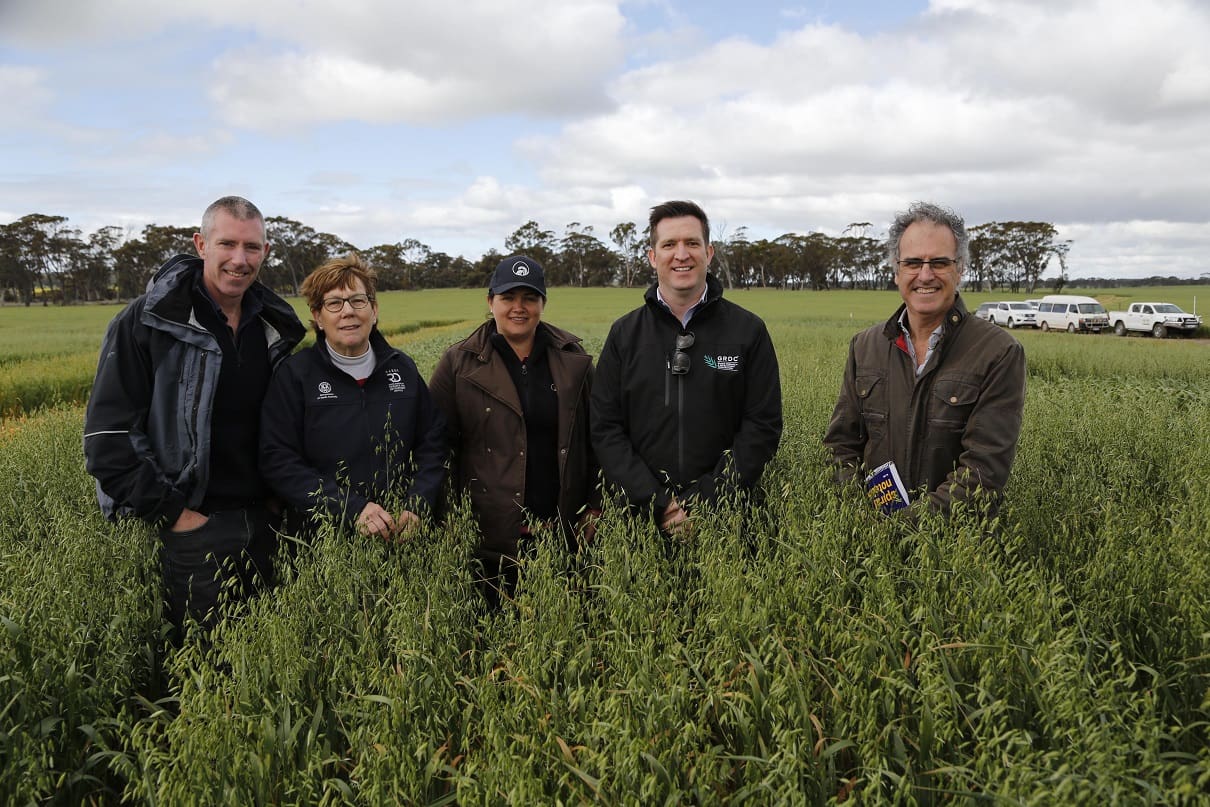
SARDI’s Tim Sutton and Pamela Zwer, DPIRD’s Georgie Troup, GRDC’s Josh Johnson, and DPIRD’s Mark Sweetingham, at the release of new oat variety Koorabup, at a field day near Highbury.
A NEW oats variety with improved disease resistance is set to open up new areas to hay production in Western Australia.
The new variety, Koorabup – the Aboriginal name for the Denmark River, meaning Black Swan – was released at a property near Highbury, in WA’s Great Southern.
Koorabup was developed by the South Australian Research and Development Institute (SARDI) with support from the WA Department of Primary Industries and Regional Development (DPIRD), as part of the National Oat Breeding program.
The variety was initially crossed in 2005 from two WA advanced breeding lines and has been tested in field trials at several locations across the nation, including Cunderdin and Highbury in WA.
SARDI principal plant breeder Pamela Zwer said Koorabup had similar traits to the popular oats variety Carrolup, but with improved resistance to fungal disease, septoria.
Septoria occurs throughout the cereal growing areas of WA and is most severe in high rainfall areas, causing crop losses of up to 50 per cent in susceptible varieties.
“The trait that sets Koorabup apart is that it is moderately resistant to moderately susceptible to septoria, whereas most oats varieties are susceptible to highly susceptible to this disease,” she said.
“This resistance can result in hay yields slightly higher than Carrolup and improved quality performance, providing an alternative cropping option – particularly for growers in the medium to high rainfall zones, where septoria is common.”
Dr Zwer said Koorabup also had characteristics highly desired by the oaten hay trade.
“This variety produces a distinctive blueish-green crop, with thin stems that meets hay processing requirements, although its water-soluble carbohydrates averaged slightly lower in WA trials,” she said.
Koorabup is regarded as a mid-tall variety, with early mid to midseason maturity.
In addition to its improved resistance to septoria, it also has good rust and bacterial blight resistances.
DPIRD Research and Industry Innovation managing director Mark Sweetingham said the National Oat Breeding program was a great demonstration of the gains that could be made by collaborative and multidisciplinary research.
“This national program draws on the expertise, resources and market intelligence from throughout the milling oat and export fodder supply chains to develop new varieties to boost profitability in this important industry,” Dr Sweetingham said.
“Cereal hay exports from WA have risen strongly in recent years, worth $175 million in 2016-17, driven by strong demand from Asia, notably Japan, South Korea, China and Taiwan.
“The variety launched today will help grow this industry in WA, while providing another option for growers to manage their cropping program in line with seasonal expectations and sustainable rotations.”
Koorabup seed has been bulked up in the past two years and will be available after harvest via the National Oat Breeding program’s alliance with commercial partner AEXCO.
The National Oat Breeding program is funded by SARDI, DPIRD, AgriFutures Australia, Uncle Tobys Company (owned by Nestle and Cereal Partners Worldwide), AEXCO and the Grains Research and Development Corporation.
Source: DPIRD
Grain Central: Get our free daily cropping news straight to your inbox – Click here



HAVE YOUR SAY